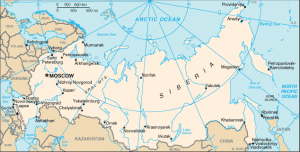At least eight people have been hospitalized with suspected tularemia in Khanty-Mansiysky Autonomous District, according to a Yekaterinburg News report today.

Image/CIA
“Two people diagnosis was confirmed, they have treated and discharged, six more are awaiting the results of the analysis,” Rospotrebnadzor Deputy head Ugra Kudryavtseva said.
Rospotrebnadzor officials say that human tularemia cases usually increase in late summer. Last September some 900 people in the Khanty-Mansiysky Autonomous District contracted tularemia, according to a Rosbalt report (computer translated). A regional emergency was declared due to the outbreak.
LISTEN: Outbreak News Radio: Tularemia in the US and GIANTMicrobes
Also known as rabbit fever and deer fly fever,tularemia is caused by the bacterium Francisella tularensis. This bacterium is found in nature in rabbits, rodents, beavers, squirrels and several domestic and farm animals.
People commonly get infected from the bites of infected ticks (wood, dog) and deer flies. Hunters are at risk of infection following skinning, dressing and eating infected animals.
Drinking contaminated water has been implicated in tularemia infection. People also contract it through inhaling dust and hay that have rodent feces and carcasses.
There have been cases where people got infected from a domestic cat. It is believed that cats get the organism from contaminated prey and their mouth and claws become infected.
Certain animal associated occupations are also associated with the disease; farmers, veterinarians, sheepherders and shearers.
The disease in people depends on how it is acquired. After infection, incubation can be a couple of days to weeks, with non-specific symptoms like fever, chills, headache, sore throat and diarrhea.
The way the organism enters the body frequently dictates the disease and degree of systemic involvement. The six syndromes are ulceroglandular, glandular, oculoglandular, oropharyngeal, typhoidal and the one with the highest mortality rate, pneumonic tularemia.
For more infectious disease news and information, visit and “like” the Infectious Disease News Facebook page

